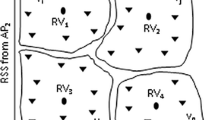Abstract
In this paper, a two-stage complexity reduction technique is implemented for a fingerprinting-based indoor positioning system. Several computation reduction techniques are applied during the offline and online phases of fingerprinting. Specifically, dimensionality reduction algorithms, clustering techniques and fast search strategies are integrated to achieve an ultimate reduction in the computational requirements of fingerprinting. The computational cost of fingerprinting is first reduced by restricting the location fingerprints to signal strength values received from informative access points (APs). Afterwards, clustering techniques are employed to speed up the online search for the target best match. Finally, selective matching between the target RSS and the pre-stored fingerprints is proposed to reduce the computational cost even further. In particular, this paper studies different dimensionality reduction methods and chooses the method that minimizes the positioning error. Moreover, a hybrid search solution of clustering and fast search strategies is proposed to minimize the search operations to find a user position in the radio map.







Similar content being viewed by others
References
Atia, M., Noureldin, A., & Korenberg, M. (2013). Dynamic online-calibrated radio maps for indoor positioning in wireless local area networks. IEEE Transactions on Mobile Computing, 12, 1774–1787.
Mohammadi, E. (2011). Indoor location based services. Master’s thesis, University of Calgary.
Liu, H., Darabi, H., Banerjee, P., & Liu, J. (2007). Survey of wireless indoor positioning techniques and systems. Systems, Man, and Cybernetics, Part C: IEEE Transactions on Applications and Reviews, 37, 1067–1080.
Rappaport, T. (2001). Wireless Communications: Principles and Practice. Upper Saddle River, NJ, USA: Prentice Hall PTR, 2nd ed.
Atia, M. M. M. (2013). Nonlinear Estimation Techniques for High-Resolution Indoor Positioning System. PhD thesis, Queen’s University, Kingston, Ontario, Canada.
Karimi, H. A. (2013). Advanced location-based technologies and services. Boca Raton: CRC Press, Taylor Francis Group.
Sayed, A., Tarighat, A., & Khajehnouri, N. (2005). Network-based wireless location: challenges faced in developing techniques for accurate wireless location information. IEEE Signal Processing Magazine, 22, 24–40.
Abusara, A., & Hassan, M. (2015). “Enhanced fingerprinting in wlan-based indoor positioning using hybrid search techniques,” In International Conference on Communications, Signal Processing, and their Applications (ICCSPA), 2015, pp. (1–6).
Wirola, L., Wirola, L., & Piche, R. (2013). Bandwidth and storage reduction of radio maps for offline WLAN positioning. In 2013 International Conference on Indoor Positioning and Indoor Navigation (IPIN), pp. (1–9).
Duda, R. O., Hart, P. E., & Stork, D. G. (2001). Pattern classification. New York: Wiley.
Ledlie, J. (2011). Method and apparatus for on-device positioning using compressed fingerprint archives, Patent no. WO 2011067466 A1.
Laitinen, E., Lohan, E., Talvitie, J., & Shrestha, S. (2012). Access point significance measures in WLAN-based location, In: 2012 9th Workshop on Positioning Navigation and Communication (WPNC), pp. (24–29).
Atia, M., Korenberg, M., & Noureldin, A. (2011). Fast features reduction of radio maps for real-time fingerprint-based wireless positioning systems. Electronics Letters, 47, 1151–1153.
Youssef, M., & Agrawala, A. (2005). The horus WLAN location determination system. In Proceedings of the 3rd International Conference on Mobile Systems, Applications, and Services, MobiSys ’05, (pp. 205–218). New York, NY, USA, ACM.
Altintas, B., and Serif, T. (2011). Improving RSS-based indoor positioning algorithm via k-means clustering. In 11th European Wireless Conference 2011 - Sustainable Wireless Technologies (European Wireless), pp. (1–5).
Li, H., Zhao, X., & Tan, M. (2011). A new search strategy of radio fingerprint matching method in wireless sensor network. In 2011 First International Conference on Robot, Vision and Signal Processing (RVSP), pp. (18–22).
Kim, J.-N., & Choi, T.-S. (1998). A fast three-step search algorithm with minimum checking points using unimodal error surface assumption. IEEE Transactions on Consumer Electronics, 44, 638–648.
Zhu, S., & Ma, K.-K. (2000). A new diamond search algorithm for fast block-matching motion estimation. IEEE Transactions on Image Processing, 9, 287–290.
Roxin, A., Gaber, J., Wack, M., & Nait-Sidi-Moh, A. (2007). Survey of wireless geolocation techniques. In 2007 IEEE Globecom Workshops, pp. (1–9).
Ma, J., Li, X., Tao, X., & Lu, J. (2008). Cluster filtered KNN: A WLAN-based indoor positioning scheme. In WoWMoM 2008. International Symposium on a World of Wireless, Mobile and Multimedia Networks, (p. 1).
Abbas, H. (2009). System identification using optimally designed functional link networks via a fast orthogonal search technique. Journal of Computers, 4(2).
Korenberg, M. (1989). A robust orthogonal algorithm for system identification and time-series analysis. Biological Cybernetics, 60(4), 267–276.
Abbas, H. (2007). A novel fast orthogonal search method for design of functional link networks and their use in system identification. In ISIC 2007. IEEE International Conference on Systems, Man and Cybernetics, (pp. 2743–2747).
Nahlawi, L. I. (2010). Genetic Feature Selection Using Dimensionality Reduction Approaches: A Comparative Study. PhD thesis, Queen’s University, Kingston, Ontario, Canada.
“Vistumbler: A wireless network scanner for Vista. (2015). Online. Available: https://www.vistumbler.net/.
Atia, M., Noureldin, A., & Korenberg, M. (2012). Dynamic propagation modeling for mobile users’ position and heading estimation in wireless local area networks. IEEE Wireless Communications Letters, 1, 101–104.
Author information
Authors and Affiliations
Corresponding author
Rights and permissions
About this article
Cite this article
Abusara, A., Hassan, M.S. & Ismail, M.H. Reduced-complexity fingerprinting in WLAN-based indoor positioning. Telecommun Syst 65, 407–417 (2017). https://doi.org/10.1007/s11235-016-0241-8
Published:
Issue Date:
DOI: https://doi.org/10.1007/s11235-016-0241-8




